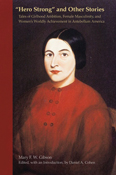Hero Strong and Other Stories
Tales of Girlhood Ambition, Female Masculinity, and Women's Worldly Achievement in Antebellum America

- Author(s): Gibson, Mary F. W.; edited by Daniel Cohen
- Series:
- Imprint: Univ Tennessee Press
- Publication Date: 2014-08-30
- Status: Active
- Available in PDF: Price $48.30 | Buy Now
- Leaf eReader required for PDF ebooks
A teenage orphan from Vermont, Mary Gibson burst onto the literary scene during the early 1850s as a star writer, under the pseudonym Winnie Woodfern, for more than half a dozen Boston “story papers,” mass-circulation weekly periodicals that specialized in popular fiction. Although she would soon join such famous woman authors as Fanny Fern and E. D. E. N. Southworth as featured contributors to the New York Ledger, America’s greatest story paper, Gibson’s subsequent output rarely matched the gender-bending creativity of the tales written in her late teens and early twenties and reprinted in this volume.
But “Hero Strong” and Other Stories does much more than recover the work of a forgotten literary prodigy. As explained by historian Daniel A. Cohen, Gibson’s tales also illuminate major interrelated transformations in American girlhood and American women’s authorship. Challenging traditional gender expectations, thousands of girls of Gibson’s generation not only aspired to public careers as writers, artists, educators, and even doctors but also began to experiment with new forms of “female masculinity” in attitude, bearing, behavior, dress, and sexuality—a pattern only gradually domesticated by the nonthreatening image of the “tomboy.” Some, such as Gibson, at once realized and reenacted their dreams on the pages of antebellum story papers.
This first modern scholarly edition of Mary Gibson’s early fiction features ten tales of teenage girls (seemingly much like Gibson herself) who fearlessly appropriate masculine traits, defy contemporary gender norms, and struggle to fulfill high worldly ambitions. In addition to several heroines who seek “fame and riches” as authors or artists, Gibson’s unconventional protagonists include three female medical students who resort to grave robbing and a Boston ingénue who dreams of achieving military glory in battle. By moving beyond “literary domesticity” and embracing bold new models of women’s authorship, artistry, and worldly achievement, Gibson and her fictional protagonists stand as exemplars of “the first generation of American girls who imagined they could do almost anything.”
Daniel A. Cohen is an associate professor of history at Case Western Reserve University. His previous publications include Pillars of Salt, Monuments of Grace: New England Crime Literature and the Origins of American Popular Culture, 1674–1860 and ‘The Female Marine’ and Related Works: Narratives of Cross-Dressing and Urban Vice in America’s Early Republic.
